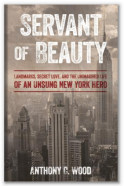
C. C. Burlingham
Also known as Charles Culp Burlingham, Charles C. Burlingham, and CCB
C. C. Burlingham spent his life laboring for civic concerns and was involved in the opposition to the Brooklyn Battery Bridge, and the preservation of Castle Clinton and Greenwich Village.
Charles Culp Burlingham (often referred to as C. C. Burlingham), a civic leader and reformer, was born on August 31, 1858, in Plainfield, New Jersey. He graduated from Harvard University in 1879, and he received his LL.B. from Columbia University in 1881. After being admitted to the bar that same year, he worked as an attorney and partner in the law firm of Burlingham and Veeder, Clark and Hupper. The New York City-based firm specialized in admiralty law. Burlingham gained notoriety for his work defending the White Star Line after the sinking of the Titanic.1
C. C. Burlingham spent his life laboring for civic concerns. In recognition of his contributions, he was often referred to as “New York’s First Citizen.” He sought to improve the administration of justice and to cleanse the New York City government of its internal corruption.2
C. C. Burlingham was a skilled writer. He authored many publications and articles including: “Francis Lewis, One of the New York Signers of the Declaration of Independence,” “Joseph Redlich” (Harvard Law Review, 1937), and “Joe Evans, 1857-1898.”3
He died on June 6, 1959 in New York City, at the age of 101.4
Association of the Bar of the City of New York
President
Board of Education in New York City
President
Welfare Council of New York City
President
Charles Culp Burlingham was a civic leader throughout his life, and preservation issues ranked high on his list of priorities. He often employed his letter writing skills and his political connections to advance preservation causes. Burlingham first battled against Robert Moses' proposed Brooklyn-Battery Bridge. In 1939, the City’s Tunnel Authority announced its plan to construct a Brooklyn-Battery Tunnel. The tunnel was approved by the U. S. Department of War. Developer Robert Moses, however, was determined to construct a Brooklyn-Battery Bridge instead of a tunnel. Moses possessed the necessary funds to back his project, and thus the City Council and State Legislature ruled in his favor. Amongst others, C. C. Burlingham actively opposed the bridge. He appealed to the First Lady, Eleanor Roosevelt, for support. He subsequently wrote a long letter, which was published in the Herald Tribune, explaining his opposition to the construction. Burlingham sent a copy of the letter to President Franklin Roosevelt. Soon after, Secretary of War, Harry Woodring, denied the permit required to construct the bridge on the grounds that it was "seaward of a vital Navy establishment, and would potentially block access from New York Harbor." The refusal spared the aesthetics of Battery Park, which would have been greatly marred by the construction of the bridge.5 Burlingham also played a role in the fight to save Castle Clinton.6 In addition, in the late 1940's, Burlingham joined the ranks of Greenwich Village activists, who fought to preserve the architectural character of the Village.7
- Charles Culp Burlingham Papers, 1876-1960
The Harvard Law School Library
Cambridge, MA 02138
Finding aid can be accessed online here.
- “Burlingham, Charles Culp. Papers, 1876-1960: Finding Aid,” Harvard University Library: Oasis: Online Archival Search Information System. Finding aid retrieved 2 March 2016
- ”Charles Culp Burlingham, New York’s First Citizen,” a lecture given by George Martin, Friday 21 March 2003 for the New York Preservation Archive Project.
- “Charles C. Burlingham: Twentieth Century Crusader, A Retrospective Exhibit at the Harvard Law School,” 25 August – 31 December, 1980.
- “Burlingham, Charles Culp. Papers, 1876-1960: Finding Aid,” Harvard University Library: Oasis: Online Archival Search Information System. Finding aid retrieved 2 March 2016
- ”Charles Culp Burlingham, New York’s First Citizen,” a lecture given by George Martin, Friday 21 March 2003 at the New York Preservation Archive Project.
- Anthony C. Wood, Preserving New York: Winning the Right to Protect A City’s Landmarks (New York: Routledge, 2008), page 49.
- Ibid, page 169.


